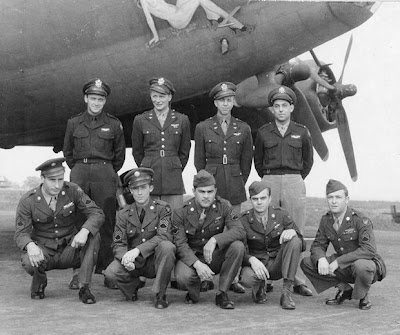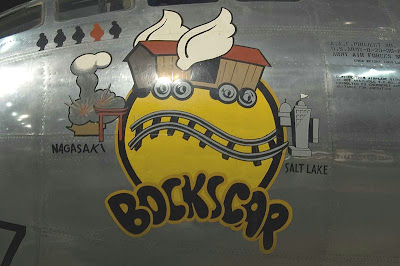Inventarío
Nose art del 303º BG
“Hell´s
angels”
Probablemente
sea el Bomb Group más famoso de la II Guerra Mundial y todo un referente para el Nose
art de los
bombarderos aliados. Fue uno de los primeros Grupos que llegó a Inglaterra y el
B-17 “Hell´s angels” fue el primero de la unidad en completar sus 25 misiones en junio de
1943. El B-17F 41-24605 “Knock-out
Dropper” sería el primer bombardero de la USAF en Inglaterra en completar
50 y después 75 misiones de combate. El grupo fue disuelto el 16 de junio de 1952. A
continuación se muestra una relación de este arte que lucieron los B-17 del “Hell´s
angels”.
Bomb Group is
probably the most famous World
War II and a reference to the Nose Art by Allied bombers. He
was one of the first groups that
came to England and the B-17 "Hell's Angels" was the
first unit to complete his 25 missions in June
1943. The B-17F
41-24605 "Knock-out Dropper" is the first USAF bomber in England
after completing 50 and 75 combat missions.
The group was dissolved on June 16, 1952. Below is a list of this art that
wore the B-17's "Hell's
Angels."
B-17F “Miss
Guachita”
42-3040
B-17F 91 /323 OR-Q. Integrante del 303º BG hasta el 17 de abril de 1943 fue
transferido al 306º BG sirviendo durante un mes hasta recibir graves daños en
combate. No fueron terminadas sus reparaciones hasta finales de agosto siendo
enviado al 91º BG. En este enlace se puede leer la historia completa de este
bombardero y su destino.
42-3040 B-17F
91/323 OR-Q. Member
of the 303rd BG until April 17, 1943 was
transferred to the 306th BG
serving for a month to receive serious
damage in combat. No repairs were completed its
to late August 91st being sent to BG. In this link
you can read the full story of the bomber and his
destiny.
B-17 “Belle
of San Joaquin”
Era un B-17F perteneciente al 360 BS (PU-I)42-5054. Asignado
al 303º BG “Hell´s angels” el 1 de mayo de 1943. Realizó un total de 8
misiones antes de ser salvaged el 11 de febrero de 1945.
He was a B-17F belonging to 360 BS (PU-I) 42-5054. Assigned
to the 303rd BG "Hell's Angels" on May 1, 1943. A total
of 8 missions before being
salvaged on February
11, 1945.
WILLARD H. BERGERON CREW - 360th BS (crew assigned 360BS: 25 July 1943 - photo: 16 Oct 1943)
B-17 “Black
Diamond Express”
B-17F 359BS
(BN-V)41-24416. Asignado al 303º BG “Hell´s angels” el 17 de junio de 1943. Se desconoce el
número total de misiones aunque 7 fueron realizadas con el 303º, finalmente fue
desguazado el 26 de octubre de 1945.
B-17F 359BS (BN-V) 41-24416. Assigned to the 303rd BG "Hell's
Angels" on June
17, 1943. Unknown number of
missions while 7
were conducted with 303 °, was finally scrapped on October 26, 1945.
B-17 “Black
Swan”
B-17F 427BS
(GN-N) 42-5780. Asignado al 303º BG “Hell´s angels” el 8 de abril
de 1943. Realizó dos misiones y resultó derribado por el impacto directo de una
bomba lanzada desde otro aparato el 1 de mayo de 1943 cerca de St. Nazaire,
Francia.
B-17F 427BS (GN-N) 42-5780.
Assigned to the 303rd BG "Hell's Angels"
on April 8, 1943. Undertook two missions and was shot down by a
direct hit from a bomb dropped from another device on May
1, 1943 near St. Nazaire, France.
B-17 “Bonnie
– B”
B-17G 359BS
(BN-P) 42-31483. Asignado al 303º BG “Hell´s angels” el 1 de enero
de 1944. Realizó un total de 93 misiones de combate siendo salvaged el 5 de
septiembre de 1944
B-17G 359BS (BN-P) 42-31483.
Assigned to the 303rd BG "Hell's Angels"
on January 1, 1944. A total of 93 combat
missions being salvaged on September 5, 1944
Fuentes/Sources:
MAURER, M. “Air Force Combat
Units Of World War II.” Maxwell, 1983
FLEMMING, S. “Flying with the
Hell's Angels” Honoribus Press, 1991
FREENY, W. “The First 300 Hell's
Angels, 303rd Bombardment Group (H). United States Army Air
Forces” Batsford, 1944
O´NEILL, B. “303rd Bombardment
Group” Osprey, 2003
SMART, V. “The Original Hell's
Angels: The 303rd Bombardment Group of World War II” Arcadia Publishing, 2001
Inventarío Nose art del 303º BG “Hell´s angels” (I)
Inventarío Nose art del 303º BG “Hell´s angels” (I)























-Walter-Oesau-WNr-1432-France-1940-02ff.jpg)












